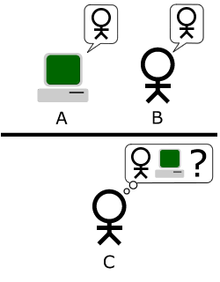Turing test
The Turing test is a test to see if a computer can interact with a person. The human should not be able to realize it is interacting with a computer.

Alan Turing thought that if a human could not tell the difference between another human and the computer, then the computer had shown intelligent behavior.[1]
Test setup
changeA person has a telegraph, and is connected to two communication partners. One of the two correspondents is a machine. The person can ask anything with the telegraph. If the person cannot tell which of the two is the machine more than 50% of the time, then the machine is said to be intelligent.
Later on, people narrowed down the test. A human is unlikely to know everything. Therefore, both the human and the machine would be specialists in some field of knowledge (and so would the person asking).
Media
changeThe comic strip Dilbert makes several mentions to the PHB (Pointy Haired Boss) failing the Turing test.
Related pages
changeReferences
change- ↑ Harnad, Stevan 2008. The Annotation Game: on Turing (1950) on Computing, Machinery and Intelligence. Archived 18 October 2017 at the Wayback Machine. In: Epstein, Robert & Peters, Grace (eds) Parsing the Turing Test: philosophical and methodological issues in the quest for the thinking computer. Springer.
Other websites
change- "Machines Who Think, on season 2, episode 5". Scientific American Frontiers. Chedd-Angier Production Company. 1991–1992. PBS. Archived from the original on 2006-01-01.